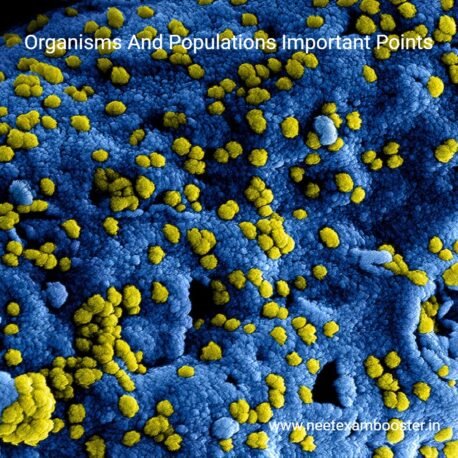Organisms and population important points For NEET: Organisms are the individual living things, such as plants, animals, fungi, and bacteria, that are capable of carrying out the life processes, such as reproduction, growth, and response to stimuli. Organisms are basic building blocks of populations, which are groups of organisms of same species that live in same area and interbreed.
Populations are the dynamic and can be affected by a variety of factors, including the competition for resources, environmental changes, and predation. Population size refers to number of individuals in a population at a particular time, while the population density is the number of individuals per unit of area or volume.
Ecologists study the populations to understand how they interact with each other and their environment. This knowledge is important for managing the natural resources, predicting spread of diseases, and preserving biodiversity.
Organisms and population important points, Organisms and population important points, Organisms and population important points, Organisms and population important points, Organisms and population important points
NCERT biology class 12 chapter 13 – 25 important points on organisms and population

There are 25 important points on organisms and population important points:
1. An organism is any living thing that can perform the basic life processes like metabolism, growth, and reproduction.
2. Populations are the groups of organisms of same species living in same area at the same time.
3. The study of populations is known as population ecology.
4. Population ecology examines how the populations interact with their environment and each other.
5. Population size is number of individuals in a population.
6. Population density is number of individuals per unit area or volume.
7. Population dispersion describes how the individuals are distributed within a population’s range.
8. Population growth rate is rate at which a population is increasing or decreasing over time.
9. The carrying capacity is maximum number of individuals that can be supported by an ecosystem.
10. Density-dependent factors are the factors that affect the populations based on their density, such as disease and competition for resources.
11. Density-independent factors are the factors that affects the populations regardless of their density, such as natural disasters.
12. The age structure of the population refers to distribution of the individuals across the different age groups.
13. Age structure can affect the population growth rates and the future population size.
14. Life history traits are characteristics of the organisms that influences their survival and reproduction.
15. These traits can include the age at first reproduction, number of offspring, and parental care.
16. R-selected species are those that have the high reproductive rates and produce many offspring with a little parental care.
17. K-selected species are those that have the low reproductive rates and produce a few offspring with a high parental care.
18. Population dynamics describes changes in population size and structure over time.
19. Predator-prey relationships are a type of population interaction that can influence the population dynamics.
20. Mutualism, commensalism, and parasitism are the other types of population interactions.
21. Invasive species can have the negative impacts on the native populations and ecosystems.
22. Conservation biology is study of protecting and managing the populations and ecosystems.
23. Endangered species are those at risk of extinction due to the human activities.
24. Habitat destruction, climate change, and overexploitation are the major threats to populations and ecosystems.
25. Sustainable practices can help to conserve the populations and ecosystems for the future generations.
Some Important Questions From Biology Class 11
| Chapter Name | Quiz Link |
| The Living World | Play Now |
| Biological Classification | Play Now |
| Plant Kingdom | Play Now |
| Animal Kingdom | Play Now |
| Morphology of flowering plants | Play Now |
| Anatomy of flowering plants | Play Now |
| Cell: the unit of life | Play Now |
| Biomolecules | Play Now |
| Cell Cycle and cell division | Play Now |
| Transport in Plants | Play Now |
| Structural organisation in Animals | Play Now |
| Mineral nutrition | Play Now |
| Photosynthesis in higher plants | Play Now |
| Respiration in plants | Play Now |
| Plant Growth and development | Play Now |
| Digestion and Absorption | Play Now |
| Breathing and Exchange of Gases | Play Now |
| Body fluids and circulation | Play Now |
| Excretory products and their elimination | Play Now |
| Locomotion and Movement | Play Now |
| Neural Control and Coordination | Play Now |
| Chemical Coordination and Integration | Play Now |
Some Important Questions From Biology Class 12
| Chapter Name | Quiz Link |
| Reproduction in organism | Play Now |
| Sexual reproduction in flowering plant | Play Now |
| Human reproduction | Play Now |
| Reproductive health | Play Now |
| Principles of inheritance and variation | Play Now |
| Molecular basis of inheritance | Play Now |
| Evolution | Play Now |
| Human health and disease | Play Now |
| Strategies for enhancement in food product | Play Now |
| Microbes in human welfare | Play Now |
| Biotechnology principles and processes | Play Now |
| Biotechnology and its application | Play Now |
| Organism and population | Play Now |
| Ecosystem | Play Now |
| Biodiversity and its conservation | Play Now |
| Environment issue | Play Now |



















